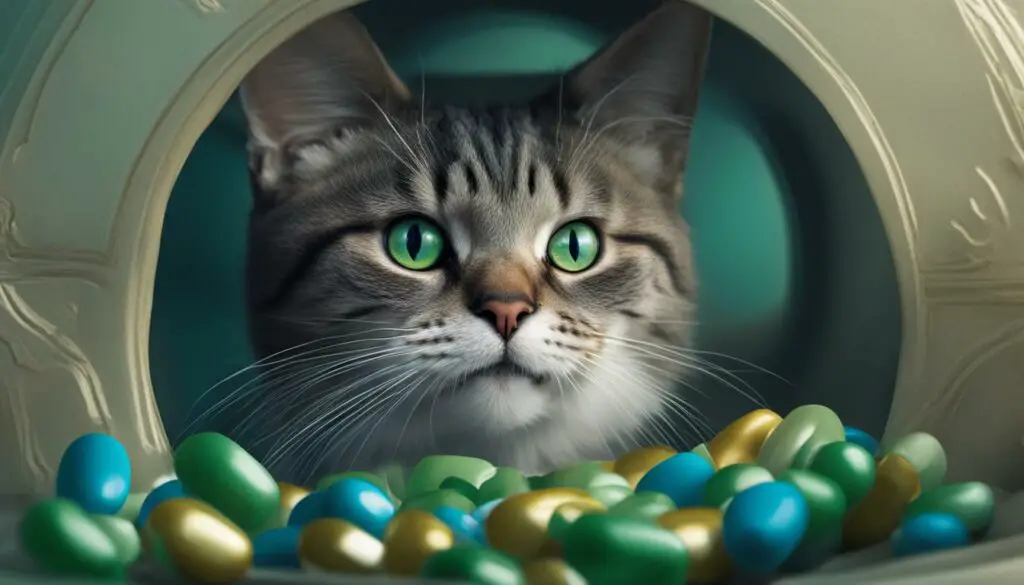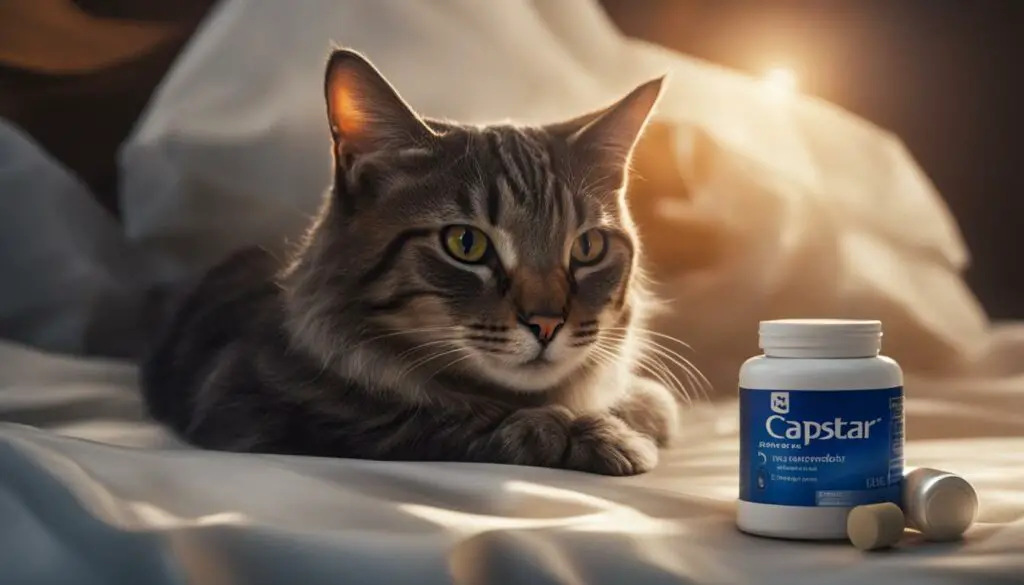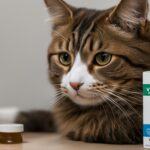Have you ever noticed your cat behaving strangely after administering Capstar flea control tablets? You’re not alone. Many pet owners have reported their cats “freaking out” or exhibiting unusual behavior after taking Capstar. But why does this happen? Let’s dive deeper into the reasons behind your Capstar cat freaking out.
Key Takeaways:
- Capstar flea control tablets have been known to cause unusual behavior in cats.
- The active ingredient in Capstar, Nitenpyram, interferes with the flea’s central nervous system, leading to their elimination.
- Cats may experience symptoms such as scratching, running out of control, and general agitation after taking Capstar.
- It’s important to monitor your cat closely and consult with your veterinarian if you have any concerns.
- Exploring natural remedies for cat anxiety and stress relief can help maintain your pet’s overall well-being.
The Pros and Cons of Using Capstar
When it comes to dealing with cat behavior problems, such as those caused by fleas, Capstar can be a useful solution. This fast-acting flea control tablet is effective for all cats and dogs over a month old and 2 pounds. One of the major advantages of Capstar is its quick action. It starts killing fleas within 30 minutes of administration, providing immediate relief for your pet.
In addition to its fast-acting formula, Capstar is also suitable for pregnant or lactating pets. This is an important consideration for pet owners who need a flea control solution that is safe to use during these periods. Furthermore, Capstar is less expensive compared to some other flea control tablets, making it a more affordable option for pet owners.
However, it’s important to note that Capstar’s effects last only 24 hours. While it provides immediate relief, it does not provide long-term protection against fleas. Additionally, Capstar is specifically designed to target fleas and does not offer protection against other pests such as ticks, mosquitoes, flies, or lice. Another aspect to consider is that Capstar tablets are unflavored, which may make them less appealing to some pets.
| Pros of Using Capstar | Cons of Using Capstar |
|---|---|
| Fast-acting formula | Effects last only 24 hours |
| Effective for all cats and dogs over a month old and 2 pounds | No protection against ticks, mosquitoes, flies, or lice |
| Suitable for pregnant or lactating pets | Unflavored tablets |
| Less expensive compared to other tablets | Possible side effects in some cases |
While Capstar is generally well-tolerated, it may cause side effects in some cases. These side effects can include lethargy, vomiting, itching, and incoordination. It’s important to monitor your pet closely after administering Capstar and consult with your veterinarian if you notice any concerning symptoms. Overall, Capstar can be an effective short-term solution for flea control, but it’s important to consider the pros and cons before using it.
Understanding the Side Effects of Capstar
When using Capstar flea control tablets for your cat or dog, it’s important to be aware of the potential side effects that may occur. While Capstar is generally considered safe when used as directed, some pets may experience adverse reactions. These side effects can range from mild to severe and may require veterinary attention. The most commonly reported side effects in both cats and dogs include lethargy, vomiting, itching, and incoordination. Other possible side effects may include diarrhea, hyperactivity, trembling, seizures, panting, vocalization, salivation, and fever.
Cats may also experience difficulty breathing, pupil dilation, and an increased heart rate. Dogs, on the other hand, may exhibit depression and allergic reactions such as hives. It’s important to monitor your pet closely after administering Capstar and seek immediate veterinary attention if you notice any concerning symptoms or behaviors.
While some pets may have no adverse reactions to Capstar, it’s always a good idea to be prepared and have a plan in place in case your pet experiences any side effects. Consult with your veterinarian for guidance on how to handle any potential reactions and to ensure the safety and well-being of your beloved furry friend.
Natural Remedies for Anxious Cats
If you’re looking for alternative ways to help calm your cat, there are several natural remedies that you can consider. These remedies can be used in conjunction with Capstar or as a standalone solution for anxiety relief. Some popular options include:
- 1. Catnip: Catnip is a natural herb that can have a soothing effect on cats and help alleviate stress and anxiety. It can be used in the form of dried leaves or as a spray on toys, bedding, or scratching posts.
- 2. Chamomile: Chamomile is known for its calming properties and can be used to make a herbal tea that can be added to your cat’s food or water. It’s important to note that not all cats enjoy the taste of chamomile, so it may take some trial and error to find the best method of administration.
- 3. Lavender: Lavender has a calming scent that can help relax cats. You can use lavender essential oil to create a soothing environment by adding a few drops to a diffuser or by spraying it on your cat’s bedding or favorite resting spots.
It’s important to remember that every cat is unique, and what works for one may not work for another. If your cat’s anxiety is severe or persistent, it’s best to consult with your veterinarian for further guidance and potential medication options.

| Side Effects | Cats | Dogs |
|---|---|---|
| Lethargy | ✔ | ✔ |
| Vomiting | ✔ | ✔ |
| Itching | ✔ | ✔ |
| Incoordination | ✔ | ✔ |
| Diarrhea | ✔ | |
| Hyperactivity | ✔ | |
| Trembling | ✔ | |
| Seizures | ✔ | |
| Panting | ✔ | |
| Vocalization | ✔ | |
| Salivation | ✔ | |
| Fever | ✔ | |
| Difficulty Breathing | ✔ | |
| Pupil Dilation | ✔ | |
| Increased Heart Rate | ✔ | |
| Depression | ✔ | |
| Allergic Reactions (Hives) | ✔ |
How Does Capstar Work?
Capstar flea control pills contain the active ingredient Nitenpyram, which is completely absorbed in the intestinal tract after dosing. Once in the bloodstream, Nitenpyram is quickly absorbed by fleas when they take a blood meal from your pet. It works by interfering with the flea’s central nervous system, leading to their elimination. However, it is important to note that Capstar does not work on young fleas, larvae, or eggs.
Nitenpyram, the active ingredient in Capstar, belongs to the neonicotinoid family of chemicals. It acts on the flea’s central nervous system by binding to acetylcholine receptors, interfering with nerve signal transmission and eventually leading to the elimination of the fleas. It is chemically stable under normal conditions of storage and is considered an effective and fast-acting solution for flea control.
To give you a better understanding of the mechanism of action of Nitenpyram, here is a simplified explanation:
- When your pet ingests Capstar, the Nitenpyram is absorbed into the bloodstream.
- When a flea feeds on your pet’s blood, it also ingests the Nitenpyram.
- The Nitenpyram interferes with the flea’s central nervous system, causing paralysis and eventual death.
- Over the next few hours, the fleas on your pet will start to die off.
- Once dead, the fleas will fall off or be easily removed during grooming.
It’s important to understand that Capstar works by killing adult fleas present on your pet at the time of administration. It does not have a residual effect and does not provide long-term protection against fleas. Therefore, it’s recommended to use Capstar in conjunction with other preventive treatments for comprehensive flea control.
| Pros | Cons |
|---|---|
| Fast-acting – kills fleas within 30 minutes of administration | Does not provide long-term protection against fleas |
| Effective on all dogs and cats over one month old and over 2 pounds | Does not work on young fleas, larvae, or eggs |
| Suitable for pregnant or lactating pets | May cause side effects such as lethargy, vomiting, and itching |
| Less expensive compared to other tablets | Does not provide protection against ticks, mosquitoes, flies, or lice |
| Can be used as a preventive medicine for protection against fleas |
Precautions When Using Capstar
When using Capstar for flea control, it is important to take certain precautions to ensure the safety and effectiveness of the treatment. Here are some key guidelines to follow:
- Buy Capstar tablets according to the weight of your dog or cat and do not attempt to divide large tablets for puppies or smaller pets.
- Treat all cats and dogs in your household at the same time to prevent re-infestation.
- Start treatment at the beginning of the flea season or as soon as fleas are observed on your pet.
- Be prepared for your pet to show signs of agitation for up to 7 hours after Capstar treatment. This is a normal reaction as the fleas begin to die off.
By following these precautions, you can help ensure that Capstar is used safely and effectively to control fleas on your pets.
It’s also worth noting that Capstar can be used in conjunction with other flea control measures, such as topical treatments or flea collars, to provide comprehensive protection against fleas. However, always consult with your veterinarian before combining any medications or treatments to avoid any potential interactions or adverse effects.
| Precautions | Steps to Follow |
|---|---|
| Buy Correct Dosage | Choose Capstar tablets according to your pet’s weight. Do not divide large tablets for smaller pets. |
| Treat All Pets | Administer Capstar to all cats and dogs in your household at the same time to prevent re-infestation. |
| Start Treatment Timely | Begin Capstar treatment at the beginning of the flea season or as soon as fleas are observed on your pet. |
| Expect Agitation | Be prepared for your pet to show signs of agitation for up to 7 hours after Capstar treatment as the fleas start to die off. |
Alternative Medications to Capstar
If Capstar is not suitable for your pet or if you’re looking for alternative options for flea and tick control, there are several other medications available in the market. These medications offer protection against a range of pests and can provide long-lasting relief for your furry friend.
One popular alternative is K9 Advantix II, which is specifically formulated for dogs. K9 Advantix II not only kills fleas and ticks, but also repels them, preventing future infestations. It is a topical solution that is easy to apply and provides protection for up to one month.
If you have both cats and dogs in your household, Frontline Plus is a versatile option. It is available for both cats and dogs and offers protection against fleas, ticks, and chewing lice. Frontline Plus is also a topical solution that is applied monthly for continuous protection.
Another effective alternative is the Seresto Flea & Tick Collar. This collar is designed to provide long-term protection against fleas and ticks, lasting up to 8 months. It is odorless and non-greasy, making it comfortable for your pet to wear. The Seresto Flea & Tick Collar is available for both cats and dogs, offering convenient and reliable pest control.

Comparison of Alternative Medications
| Medication | Type | Duration of Protection | Target Pests |
|---|---|---|---|
| K9 Advantix II | Topical solution | 1 month | Fleas, ticks, mosquitoes, biting flies, lice |
| Frontline Plus | Topical solution | 1 month | Fleas, ticks, chewing lice |
| Seresto Flea & Tick Collar | Collar | Up to 8 months | Fleas, ticks |
When considering alternative medications to Capstar, it’s important to consult with your veterinarian to determine the most suitable option for your pet’s specific needs. They can provide personalized recommendations based on your pet’s health condition, age, and lifestyle. Remember to always follow the instructions provided by the manufacturer for safe and effective use of these medications.
Common Reactions to Capstar
Many pet owners have shared their experiences with Capstar and reported common reactions in their cats and dogs. These reactions are often described as “freaking out” or a “tickle effect” and are a result of the fleas dying after taking Capstar. While these reactions can be concerning, it’s important to understand that they are temporary and typically subside after a certain period of time. They are a normal reaction to the fleas being eliminated from your pet’s body.
During this period, you may notice your pet scratching, running around uncontrollably, or displaying signs of agitation. Your pet may appear restless or seem more hyperactive than usual. These reactions can last for a few hours and then gradually subside. It’s important to provide a calm and soothing environment for your pet during this time and ensure they have a safe space to retreat to if needed.
While these common reactions can be alarming, they are generally not a cause for concern. However, if your pet’s behavior becomes excessively agitated or if you notice any other concerning symptoms, it’s always best to consult with your veterinarian for further guidance and reassurance.
Testimonials from Pet Owners:
“After giving my cat Capstar, she started running around the house like crazy! It was like she was suddenly filled with energy. But after a few hours, she settled down and seemed much more comfortable. It was definitely a strange initial reaction, but I’m glad to know it’s normal.”
– Emily S.
“I was a little worried when my dog started scratching and acting really restless after taking Capstar. But I spoke to my vet, and she assured me that these reactions are common and temporary. Sure enough, after a few hours, my dog was back to her usual self, and the scratching had stopped. It’s a small price to pay for effective flea control.”
– Mike T.
| Common Reactions to Capstar | Duration | How to Help Your Pet |
|---|---|---|
| Scratching | A few hours | Provide a calm environment and avoid triggering their itchiness. If necessary, consult with your vet for additional relief options. |
| Restlessness | A few hours | Ensure your pet has a safe space to retreat to and offer comforting measures such as gentle petting or soothing music. |
| Agitation | A few hours | Stay calm and reassure your pet with a soothing voice. Avoid any sudden movements or loud noises that may add to their agitation. |
Personal Experience with Capstar
When it comes to my personal experience with Capstar for cats, I have found it to be quite effective in controlling fleas. However, I have also come across some side effects that are worth considering before using this product on your feline friend. It’s important to note that every cat may react differently to medication, so it’s crucial to consult with your veterinarian before administering Capstar.
One of the notable side effects I observed in my cat was extreme agitation. After taking Capstar, my cat seemed to be very restless and displayed signs of fatigue and disorientation. These reactions lasted for a significant amount of time and it was a cause for concern. In some cases, pets may require veterinary attention if the side effects persist or worsen. Therefore, it’s essential to closely monitor your cat and seek professional advice if needed.
Despite the side effects, Capstar can still be a useful tool in the fight against fleas. However, it’s crucial to weigh the potential risks and benefits, especially if your cat is prone to sensitivity or has pre-existing health conditions. Your vet can guide you in making an informed decision and recommend alternative solutions if Capstar is not suitable for your pet.
Using Capstar for cats can be an effective solution for flea control, but it’s important to consider the potential side effects and consult with your veterinarian before use. Every cat is unique, and what works well for one may not work for another. It’s always better to be safe than sorry when it comes to the well-being of our furry friends.
In conclusion, Capstar for cats can be a valuable tool in controlling fleas, but it’s essential to approach it with caution. Keep a close eye on your cat’s behavior and consult with your veterinarian if you have any concerns. Consider alternative options and natural remedies for flea control and cat stress relief to ensure your pet’s overall well-being. Remember, your cat’s health should always be a top priority.

Potential Risks and Side Effects of Capstar
When using Capstar for flea control in dogs and cats, it’s important to be aware of the potential risks and side effects associated with this medication. While Capstar is generally considered safe when used as directed, there is a risk of adverse effects, especially if the dosage is exceeded or if your pet has an allergic reaction. It’s essential to understand these risks and closely monitor your pet’s health after administering Capstar.
One potential risk of Capstar is an overdose, which can occur if the recommended dosage is exceeded. Symptoms of an overdose may include excessive salivation, tremors, seizures, and even loss of consciousness. If you suspect an overdose, it’s crucial to seek immediate veterinary attention for your pet.
Additionally, some dogs and cats may have an allergic reaction to Capstar. Common signs of an allergic reaction include itching, hives, swelling of the face or limbs, difficulty breathing, and even collapse. If you notice any of these symptoms after giving your pet Capstar, it’s important to stop the medication and consult with a veterinarian.
Potential Side Effects of Capstar
In addition to the potential risks, Capstar may also cause side effects in some pets. These side effects can range from mild to severe and may include vomiting, diarrhea, lethargy, incoordination, and even seizures. It’s important to be vigilant and observe your pet closely for any changes in behavior or health after administering Capstar.
Capstar for Dogs and Cats: Reviews and Considerations
When considering the use of Capstar for your dog or cat, it’s also helpful to read reviews from other pet owners who have used this medication. This can provide valuable insights into the effectiveness and potential side effects of Capstar. However, it’s important to remember that every pet is unique, and individual experiences may vary.
Before using Capstar, it’s always a good idea to consult with your veterinarian. They can assess your pet’s specific needs, weigh the potential risks and benefits, and provide you with personalized advice. Your veterinarian may also recommend alternative flea control options that could be more suitable for your pet’s individual circumstances.
| Side Effects of Capstar | Precautions | Considerations |
|---|---|---|
| Vomiting | Do not exceed recommended dosage | Monitor your pet closely for any adverse effects |
| Diarrhea | Consult with a veterinarian before using Capstar | Read reviews and consider alternative options |
| Lethargy | Be aware of potential allergic reactions | Seek veterinary attention if overdose is suspected |
| Incoordination | Observe your pet for any changes in behavior | Consult with a veterinarian for personalized advice |
| Seizures | Stop medication and seek veterinary attention if needed | Consider the potential risks and benefits of Capstar |
Safety and Dosage Range of Capstar
When it comes to using Capstar flea medication, understanding the correct dosage and ensuring safety for your pet is crucial. Capstar is dosed at 1mg/kg orally for both cats and dogs. It is important to administer the correct dosage based on your pet’s weight to ensure effectiveness and minimize the risk of adverse effects.
Capstar has been found to have a wide safety range, which means it is generally considered safe even at higher dosages. For example, a 25-pound dog would receive an 11.4 mg dose of Capstar, which falls within the safe dosage range of 1kg to 11.36kg. This demonstrates the safety of Capstar when administered correctly and according to the recommended guidelines.
In order to ensure your pet’s safety and well-being, it is always best to consult with your veterinarian before administering any medication. They can provide specific dosage instructions based on your pet’s individual needs and circumstances. Additionally, they can evaluate any potential risks or contraindications based on your pet’s medical history and current medications.
Remember, proper dosing and safety precautions are vital when using Capstar or any other flea medication. By following the recommended dosage guidelines and seeking professional advice, you can help protect your beloved pet from fleas while ensuring their overall health and well-being.

Understanding the Mechanism of Action of Nitenpyram
Nitenpyram, the active ingredient in Capstar, is a powerful flea control solution that works by targeting the central nervous system of fleas. This neonicotinoid chemical binds to acetylcholine receptors, interfering with nerve signal transmission and ultimately leading to the elimination of fleas. Its fast-acting nature ensures that fleas begin to die within 30 minutes of administration, providing quick relief for pets suffering from flea infestations.
Once Nitenpyram is absorbed into the bloodstream after dosing, fleas become exposed to the chemical when they feed on the blood of your pet. The binding of Nitenpyram to the acetylcholine receptors disrupts the normal functioning of the flea’s nervous system, causing paralysis and ultimately death. It is important to note that Nitenpyram is only effective against adult fleas and does not target the eggs, larvae, or young fleas present in the environment.
Capstar’s active ingredient, Nitenpyram, has been proven to be an effective and safe solution for flea control. Its mechanism of action specifically targets fleas while minimizing the risk of toxicity to pets. However, it is crucial to follow the recommended dosage based on your pet’s weight and to be aware of possible side effects. Consulting with your veterinarian before using Capstar is always recommended to ensure that it is the appropriate choice for your pet’s specific needs.
The Mechanism of Action of Nitenpyram:
- Nitenpyram is administered orally, either in tablet or capsule form.
- Once absorbed into the bloodstream, it binds to acetylcholine receptors present in the flea’s nervous system.
- This binding interferes with the transmission of nerve signals, leading to paralysis and death of the flea.
- The fast-acting nature of Nitenpyram ensures that fleas begin to die within 30 minutes of administration.
- It is important to note that Nitenpyram only targets adult fleas and does not affect eggs, larvae, or young fleas.
In summary, the active ingredient Nitenpyram in Capstar works by disrupting the central nervous system of fleas, leading to their elimination. Its fast-acting nature and effectiveness against adult fleas make it a popular choice for pet owners dealing with flea infestations. However, it is important to use Capstar as directed and consult with your veterinarian to ensure the safety and suitability of this flea control solution for your pet.
| Nitenpyram Mechanism of Action | Summary |
|---|---|
| Nitenpyram is administered orally in tablet or capsule form. | Fast-acting and begins to kill fleas within 30 minutes of administration. |
| It binds to acetylcholine receptors in the flea’s nervous system, causing paralysis and death. | Targeted action against adult fleas, but does not affect eggs, larvae, or young fleas. |
| Nitenpyram is safe and effective when used as directed. | Consult your veterinarian for proper dosage and to ensure suitability for your pet. |
The Importance of Proper Research Before Using Capstar
When considering the use of any flea medication, such as Capstar, it is crucial to conduct proper research. This means gathering information about the product, understanding its potential side effects, and considering user reviews and experiences. By doing so, pet owners can make informed decisions that prioritize the safety and well-being of their furry companions.
Capstar research allows pet owners to familiarize themselves with the medication’s active ingredient, Nitenpyram, and its mechanism of action. Understanding how Capstar works can help owners gauge its effectiveness and assess whether it is the right choice for their pet’s needs. Additionally, researching Capstar user reviews provides valuable insights into the experiences of other pet owners, providing a broader perspective on the medication’s pros and cons.
It’s important to note that individual experiences may vary, and what works for one pet may not work for another. Reading a variety of user reviews can help establish a balanced view and offer a better understanding of the potential side effects and effectiveness of Capstar. However, it’s equally important to consult with a veterinarian before administering any flea medication to ensure it is suitable for your pet’s specific needs.
Proper research empowers pet owners to make well-informed decisions about flea control and ensures the optimal health and comfort of their beloved pets. By taking the time to gather information, consider user reviews, and consult with professionals, pet owners can confidently select the most appropriate flea control solution for their cat or dog.

Expert Tip:
It’s always a good idea to consult with your veterinarian before introducing any new medication or treatment to your pet’s routine. They can provide personalized advice based on your pet’s specific needs and help determine if Capstar is the right choice for your furry friend.
Conclusion
In conclusion, while Capstar can be an effective flea control solution for cats and dogs, it is important to consider alternative medications and natural remedies for cat anxiety and stress relief. Natural remedies such as pheromone diffusers, calming vests, and interactive toys can help alleviate anxiety in cats. Additionally, creating a stress-free environment with hiding spots, vertical spaces, and a consistent routine can greatly contribute to your cat’s overall well-being and reduce the need for medications.
Consulting with your veterinarian is crucial to determine the best course of action for your pet’s specific needs. They can provide guidance on the most suitable flea control treatment and recommend additional measures to keep your cat calm and stress-free. Remember, a holistic approach that combines preventive measures, natural remedies, and veterinary care is key to ensuring the health and happiness of your furry friend.
By understanding the potential risks and side effects of Capstar, being aware of its limited duration of action, and exploring alternative solutions, you can make an informed decision that prioritizes the well-being of your pet. Remember, the ultimate goal is to provide comprehensive flea control while ensuring your cat’s comfort and happiness. So, take the time to research and consider all available options before deciding on the most suitable flea control solution for your furry companion.
FAQ
What is Capstar?
Capstar is a fast-acting flea control tablet for dogs and cats over one month old and over 2 pounds. It begins killing fleas within 30 minutes of administration.
Can Capstar be used with other treatments?
Yes, Capstar can be used in conjunction with preventive treatments to provide comprehensive protection against fleas. However, caution should be taken when combining it with other medications to avoid adverse effects.
What are the pros of using Capstar?
Capstar is known for its quick action, effectiveness on all cats and dogs over a month old and 2 pounds, and its suitability for pregnant or lactating pets. It is also less expensive compared to other tablets and can be used as a preventive medicine for protection against fleas.
What are the cons of using Capstar?
Capstar’s effects last only 24 hours, it does not provide protection against ticks, mosquitoes, flies, or lice, and it may cause side effects such as lethargy, vomiting, itching, and incoordination in some cases.
Can Capstar cause side effects?
Yes, Capstar may cause side effects in both cats and dogs, including lethargy, vomiting, itching, inappetence, diarrhea, hyperactivity, incoordination, trembling, seizures, panting, vocalization, salivation, fever, difficulty breathing, pupil dilation, increased heart rate, depression, and hives.
How does Capstar work?
Capstar contains the active ingredient Nitenpyram, which is absorbed in the intestinal tract and quickly kills fleas when they take a blood meal from your pet. It works by interfering with the flea’s central nervous system, leading to their elimination.
Are there any precautions when using Capstar?
Yes, it’s important to buy tablets according to your pet’s weight, treat all cats and dogs in the household at the same time, and start treatment at the beginning of the flea season or when fleas are first observed. Pets may show signs of agitation for up to 7 hours after Capstar treatment, which is a normal reaction to the fleas dying.
Are there alternative medications to Capstar?
Yes, alternative medications for flea control include K9 Advantix II for dogs, Frontline Plus for cats and dogs, and Seresto Flea & Tick Collars, which provide protection against fleas and ticks for up to 8 months.
What are common reactions to Capstar?
Some pet owners have reported their cats and dogs experiencing “freaking out” or a “tickle effect” after taking Capstar. This is a normal reaction caused by the fleas dying and is characterized by scratching, running out of control, and general agitation for a certain period of time.
What is the personal experience with Capstar?
Some pet owners have reported severe reactions in their cats, including extreme agitation, fatigue, and disorientation. It’s important to consider these personal experiences and consult with a veterinarian if you have any concerns.
Are there any potential risks and side effects of Capstar?
While Capstar is generally considered safe when used as directed, there is a risk of allergic reactions, moderate to severe neurological signs, and even seizures. Immediate veterinary attention should be sought if an overdose or concerning symptoms are suspected.
What is the safety and dosage range of Capstar?
Capstar is dosed at 1mg/kg orally for cats and dogs and has a wide safety range. It is considered safe even at higher dosages.
How does Nitenpyram work?
Nitenpyram, the active ingredient in Capstar, acts on the flea’s central nervous system by binding to acetylcholine receptors, interfering with nerve signal transmission, and eventually eliminating the fleas.
Why is proper research important before using Capstar?
Proper research, including user reviews and experiences, is essential before using Capstar or any flea medication on your pet. It provides valuable insights into potential side effects and effectiveness. Consulting with a veterinarian is also recommended.








